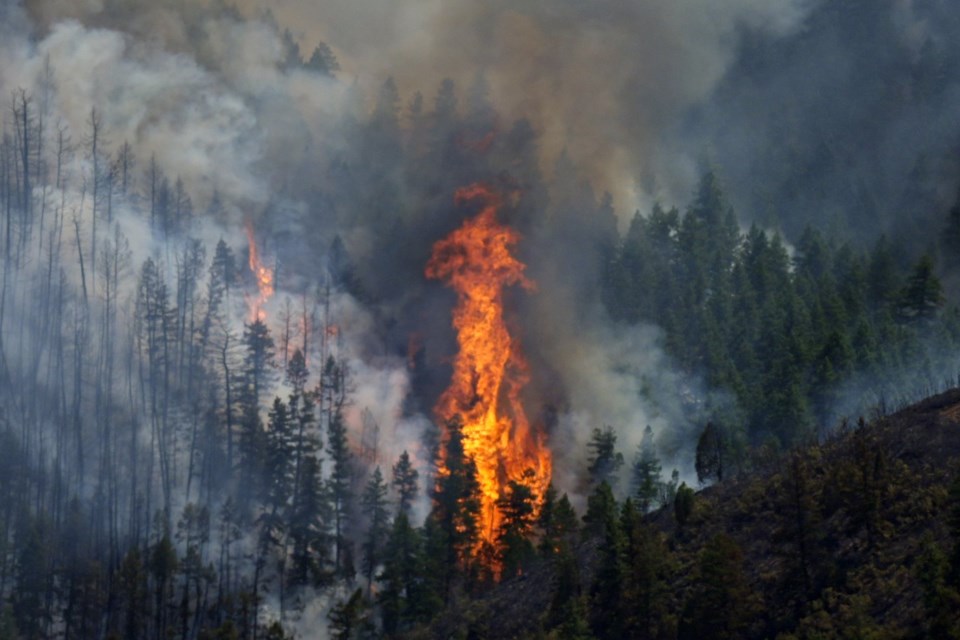LOVELAND, Colo. (AP) — A person was killed in one of several threatening heavily populated areas of the Colorado foothills, authorities said Wednesday, as almost 100 large blazes burned across the western U.S.
The death came in a fire near the town of Lyons that blackened more than two square miles (six square kilometers) by Wednesday afternoon, authorities said. The person's remains were discovered in one of five homes that burned, Boulder County Sheriff Curtis Johnson said without providing further details.
Though listed as zero percent contained, the Stone Canyon Fire was not growing significantly Wednesday as 150 firefighters battled the flames, Johnson said. It was one of several large fires burning along Colorado's Front Range, a densely populated corridor that includes Denver and stretches roughly 80 miles (130 kilometers) along the eastern edge of the Rocky Mountains.
A fire at the edge of the Denver metro area west of the small town of Conifer triggered evacuation orders for about 575 houses from several subdivisions overnight Tuesday. That fire was less than one square mile (2.5 square kilometers) as of midday Wednesday but was expected to grow with temperatures forecast to reach nearly 100 degrees (38 Celsius).
A plane was dropping fire retardant and four helicopters were dropping water from a nearby reservoir on that fire. It was burning in steep terrain, making it hard to combat from the ground, said Mark Techmeyer with the Jefferson County Sheriff’s Office.
“This fire is not an easy fight. The terrain is treacherous,” he said.
A third large fire burned more than 10 square miles (27 square kilometers) west of the town of Loveland, where 4,000 people remained under evacuation orders.
Loveland-area resident Becca Walter said her parents, who also live in the area, sent her a photo of flames climbing a nearby ridge Wednesday morning. They moved their eight horses to a friend’s ranch before evacuating to Walter’s house. She worried her parent's house could be lost.
“You can rebuild a house, and you can rebuild a barn, but there are lot of memories in them that you can’t rebuild,” she said
Yet another fire ignited Wednesday afternoon and prompted evacuation orders southwest of Boulder in the Gross Reservoir area. Two structures burned — at least one of them a house — and two firefighters suffered unspecified injuries, officials aid.
The fire was human-caused and authorities were talking to two people who may have been involved, Sheriff Johnson said, adding it did not appear intentional. The fire was held to about five acres (2 hectares) by Wednesday evening, he said.
Hot, dry weather and wind gusts of up to 30 mph (50 kph) were expected Wednesday across the Front Range, elevating the fire danger. Forecasters said the high temperatures were expected to persist into early next week but lighter winds in coming days could make it easier to control the blazes.
Colorado National Guard units were activated to help, Gov. Jared Polis said during a news conference in Loveland. He said it's the first use of the guard in such fashion since a December 2021 fire killed two people and destroyed nearly 1,100 homes in heavily populated suburbs between Denver and Boulder.
Under the haze of wildfire smoke, Polis warned of air quality “taking a turn for the worst" with the fire near Loveland expected to burn for weeks or months.
While most people heeded evacuation orders, some have refused, Polis said. He urged them to consider a few nights away from home over the possibility of losing their lives.
A plane involved in the Stone Canyon Fire inadvertently dropped fire-retardant slurry containing phosphorous and ammonia-based ingredients into a water canal leading to Boulder Reservoir on Tuesday, city officials said. Although the reservoir is not being used for drinking water, officials advised against fishing there and urged people to keep their dogs out of the waters.
A federal judge ruled last year that the U.S. government was by dropping retardant into areas with waterways. But the judge allowed the practice to continue after officials said lives and property were at stake.
Across the U.S. almost 28,000 firefighters were battling 95 large fires, according to the National Interagency Fire Center.
Almost 7,000 square miles (18,000 square kilometers) have burned nationwide so far this year, an area nearly the size of New Jersey and well above the 10-year average for this time of year.
Evacuation orders were in effect for more than two dozen fires.
Fires in southeastern Wyoming triggered evacuations in Hartville, with about 65 people, and unincorporated Pleasant Valley. Helicopters and heavy tankers were deployed against the fires, which had grown to about 47 square miles (120 square kilometers) by Wednesday morning, Gov. Mark Gordon said.
, the massive Park Fire has scorched 609 square miles (1,577 square kilometers), according to the California Department of Forestry and Fire Protection. The blaze started in Butte County last week after authorities say a man down a ravine. Flames destroyed 361 structures and threaten thousands more.
Fire officials hoped to take advantage of milder weather ahead of triple-digit temperatures forecast for Thursday through next week.
“We’re going into the heart of the fire season starting in August. We’ve got a long road ahead of us,” Billy See, a Cal Fire incident commander for the Park Fire, told firefighting crews.
In Southern California, firefighters made progress on fires in the Sequoia National Forest that led to evacuations. One scorched through almost the entirety of the historic mining town of Havilah.
Fires statewide have overwhelmed California’s firefighting capacity but outside help has begun to arrive, officials said.
Large fires also were burning in Oregon, Idaho, Washington and Montana.
__
Brown reported from Billings, Montana, Rodriguez reported from San Francisco and Slevin reported from Denver.
Jesse Bedayn, Matthew Brown, Colleen Slevin And Olga Rodriguez, The Associated Press




